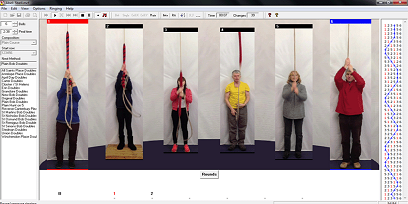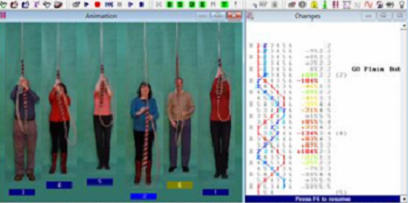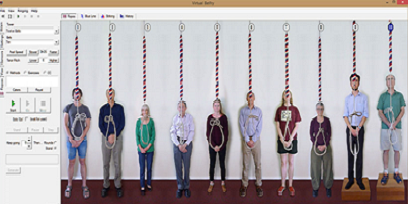Simulator software



Key features of the applications
All of the packages have huge amounts of functionality and this is evolving all of the time. There are currently three main software applications offering full simulation on PCs. All have developed a "moving ropes" screen with videos of real ringers to give a virtual reality effect.
Besides the graphic displays, which can be viewed as you ring or afterwards to see how well you have done, the latest releases of all three software packages include the facility to record your ringing and to play it back afterwards.
The packages all include accuracy statistics allowing you to measure how your accuracy improves over time. There are usually two statistics: one measures the overall error at each stroke; this can be useful in a tower situation to tell whether you are consistently quick on one stroke or another. As errors can be positive or negative and cancel each other out, a second statistic, "average error" or "standard deviation", is usually provided, which measures how variable the striking is overall.
» Find out more about accuracy statistics
Once you have mastered ringing a bell at a steady speed in rounds, you can then move on to practising call changes. At home or on your smartphone, you can use the software to help understand the theory. In the tower, with an instructor, you can practise physically ringing the bell quicker or slower at handstroke. Kaleidoscope exercises allow you to practise changing place at backstroke as well, and to increase the frequency of the changes of speed, till you have mastered the three speeds of ringing at both strokes. These exercises are pre-programmed into some of the packages, as are most of the exercises for Learning the Ropes Levels 2 to 5.
All of the packages have video clips of moving ringers so that when practising on a bell with a sensor you can watch the other ropes and practise your ropesight. They also include features to help you spot which bell you should be following, such as flashes or winks.
Getting the most out of your simulator software
A series of short videos:
Abel (left)
Abel is probably the commonest application in use and was first released by Chris Hughes in 1993. Since then ringers have bought more than 10,000 copies. If you have an older version of Abel it can be upgraded for free by downloading an update from the Abel website.
Beltower (middle)
Developed by Derek Ballard, the Beltower licence has been extended to allow any version of Beltower previously supplied by the author to be installed in any bell tower or mini-ring for training purposes. BelTutor (the cut down version for training) is effectively freeware and may be copied and passed around freely.
Virtual Belfry (right)
Developed by Doug Nichols, each copy of Virtual Belfry is licensed to a particular computer, although if you own several computers, additional license keys are provided free of charge.
ART merely informs and advises where it can – it does not have any software or hardware bias or recommendation.